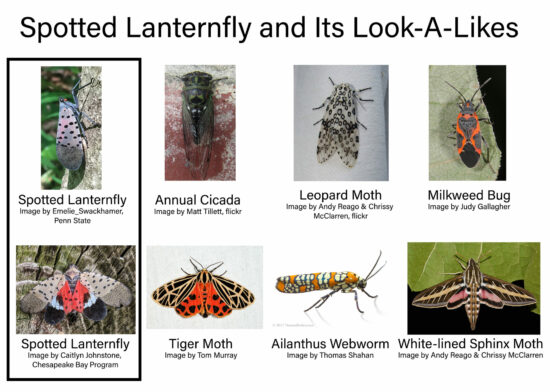Montgomery County is now part of a spotted lanternfly quarantine zone. What does that mean and what should we do? Learn more on this page.
 Native to China, lanternflies first appeared on the eastern U.S. coast in 2014 in Pennsylvania, and were first reported in Maryland in 2018. The insects are not venomous and do not bite humans, but can damage host plants in two ways:
Native to China, lanternflies first appeared on the eastern U.S. coast in 2014 in Pennsylvania, and were first reported in Maryland in 2018. The insects are not venomous and do not bite humans, but can damage host plants in two ways:
- Adults deposit eggs on a host plant and when the nymphs emerge, they insert their sucking beaks into leaves and stems and feed on the tissue, robbing the plant of valuable nutrients.
- They excrete a sugar-rich, sticky liquid from their backsides known as honeydew. Falling from infested trees like a gentle rain shower, the honeydew can kill grapevines and fouls other foliage and fruit. It promotes the growth of black, sooty mold, which can coat plants and prevent sunlight from reaching their leaves, reducing photosynthesis. The fruit becomes unmarketable, thus presenting a huge economic problem for growers of apples, cherries, peaches and grapes. Honeydew also adds a sticky coating to cars and lawn furniture, creating a mess to clean up. The sweet liquid attracts yellow jackets, wasps and ants.
Spotted lanternfly nymphs undergo four stages of maturing toward adulthood, according to the state agriculture department. During the first three, the creature is black with white spots. But during the fourth and final stage before adulthood, the half-inch-long lanternfly nymph becomes bright red, covered in black stripes and white spots. They appear in this stage from July to September. Adult spotted lanternflies, meanwhile, can be seen from July until December.
What to Do
- Report lanternfly sightings here, or contact the Maryland Department of Agriculture at (410) 841-5920 or [email protected].
- Take these steps to reduce the spread of the invasive sap-feeding plant pests:
- Check your vehicle: Before leaving a parking lot or work site, inspect vehicles for spotted lanternfly egg or insects. Check doors, sides, bumpers, wheel wells, grills and roofs. If found, destroy any eggs or insects you find.
- Inspect items being moved: Check check backpacks, bicycles, trash cans, lumber, shipping containers, propane tanks, pallets and other items being stored outdoors before they are moved offsite. Inspect incoming goods for egg masses and insects.
- Park with windows closed: The spotted lanternfly and its nymphs can enter vehicles unsuspectedly. When parked, make sure to keep windows closed. If possible, try to park 15 feet away from trees if in a quarantine zone.
 Remove and destroy pests: Crush nymphs and adult insects. Scrape egg masses into a plastic bag and place them in the trash. But don’t kill any look-alikes!
Remove and destroy pests: Crush nymphs and adult insects. Scrape egg masses into a plastic bag and place them in the trash. But don’t kill any look-alikes!- Remove host trees: While spotted lanternflies feed on a variety of host plants including fruit trees, ornamental trees, woody trees, vegetables, herbs, grains and vines, they prefer Ailanthus altissima, also known as “Tree of Heaven.” Consider choosing other species when planting new trees. You can also remove any existing “Trees of Heaven,” but first read this article by Grove resident Jay Everhart about potential difficulties in removing them.
